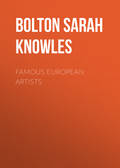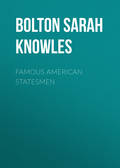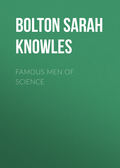
Bolton Sarah Knowles
Famous Givers and Their Gifts
DANIEL P. STONE AND VALERIA G. STONE
When Mr. Stone, who was a dry-goods merchant of Boston, died in Malden, Mass., in 1878, it was agreed between him and his wife, Mrs. Valeria G. Stone, that the property earned and saved by them should be given to charity.
While Mrs. Stone lived she gave generously; and at her death, Jan. 15, 1884, over eighty years old, she gave away more than $2,000,000. To Andover Theological Seminary, to the American Missionary Association for schools among the colored people, $150,000 each, and much to aid struggling students and churches, and to save mortgaged homes. To Wellesley College to build Stone Hall, $110,000; to Bowdoin College, Amherst, Dartmouth, Drury, Carleton, Chicago Seminary, Hamilton, Iowa, Oberlin, Hampton Institute, Woman's Board for Armenia College, Turkey, Olivet College, Ripon, Illinois, Marietta, Beloit, Robert College, Constantinople, Berea, Doane, Colorado, Washburne, Howard University, each from five to seventy-five thousand dollars. She gave also to hospitals, city mission work, rescue homes, and Christian associations. For evangelical work in France she gave $15,000.
SAMUEL WILLISTON,
The giver of over one million and a half dollars was born at Easthampton, Mass., July 17, 1795.
He was the son of the Rev. Payson Williston, first pastor of the First Church in Easthampton in 1789, and the grandson of the Rev. Noah Williston of West Haven, Conn., on his father's side, and of the Rev. Nathan Birdseye of Stratford, Conn., on his mother's.
As the salary of the father probably never exceeded $350 yearly, the family were brought up in the strictest economy. At ten years of age the boy Samuel worked on a farm, earning for the next six years about seven dollars a month, and saving all that was possible. In the winters he attended the district school, and studied Latin with his father, as he hoped to fit himself for the ministry.
He began his preparation at Phillips Academy, Andover, carrying thither his worldly possessions in a bag under his arm. "We were both of us about as poor in money as we could be," said his roommate years afterward, the Rev. Enoch Sanford, D.D., "but our capital in hope and fervor was boundless." Samuel's eyes soon failed him, and he was obliged to give up the project of ever becoming a minister. He entered the store of Arthur Tappan, in New York, as clerk; but ill health compelled him to return to the farm with its out-door life.
When he was twenty-seven he married Emily Graves of Williamsburg, Mass. She brought to the marriage partnership a noble heart, and every willingness to help. The story is told that she cut off a button from the coat of a visitor, with his consent, learned how it was covered, and soon furnished work for her neighbors as well as herself.
After some years Mr. Williston began in a small way to manufacture buttons, and the business grew under his capable management till a thousand families found employment. He formed a partnership with Joel and Josiah Hayden at Haydenville, for the manufacture of machine-made buttons in 1835, then first introduced into this country from England. Four years later the business was transferred to Easthampton.
Mr. Williston did not wait till he was very rich before he began to give. In 1837 he helped largely towards the erection of the First Church in Easthampton. In 1841 he established Williston Seminary, which became a most excellent fitting-school for college. During his lifetime he gave to this school about $270,000, and left it at his death an endowment of $600,000.
He was also deeply interested in Amherst College, establishing the Williston professorship of rhetoric and oratory, the Graves, now Williston, professorship of Greek, and some others. "He began giving to Amherst College," writes Professor Joseph H. Sawyer, "when the institution was in the depths of poverty and well-nigh given over as a failure. He saved the college to mankind, and by example and personal solicitation stimulated others to give." He built and equipped Williston Hall, and assisted in the erection of other buildings.
He aided Mary Lyon, in establishing Mount Holyoke Seminary, gave to Iowa College, the Protestant College in Beirut, Syria, and to churches, libraries, and various other institutions.
He was active in all business enterprises, as well as works of benevolence. He was president of the Williston Cotton Mills, the First National Bank, Gas Company, and Nashawannuck (suspender) Company, all at Easthampton. He was the first president of the Hampshire and Hampden Railway, president of the First National Bank of Northampton, also of the Greenville Manufacturing Company (cotton cloths), member of both branches of the Legislature until he declined a re-election, one of the trustees of Amherst College, of the Westborough, Mass., Reform School, on the board of an asylum for idiots in Boston, a corporate member of the American Board, a trustee of Mount Holyoke Seminary, etc.
Mr. Williston overcame the obstacles of poor eyesight, ill health, and poverty, and became a blessing to tens of thousands. His wife was equally a giver with him. The Rev. William Seymour Tyler, D.D., of Amherst College, said at the semi-centennial celebration of Williston Seminary, June 14-17, 1891, "I knew its founders. I say 'founders,' for Mrs. Williston had scarcely less to do than Mr. Williston in planning and founding the building and endowing the seminary, as in all the successful measures and achievements of his remarkable and useful life; and the few enterprises in which he did not succeed were those in which he did not follow her advice. I knew the founders from the time when, at the beginning of their prosperity, their home and their factory were both in a modest wing of Father Williston's parsonage, until they had created Williston Seminary, made Easthampton, following out their great and good work, and entered into their rest."
Five children were born to Mr. and Mrs. Williston, but all died in childhood. They adopted five children, two boys and three girls, reared them, and educated them for honored positions in life.
Mr. Williston died at Easthampton, July 17, 1874; and his wife, two years younger than he, died April 12, 1885. Both are buried in the cemetery at Easthampton, to which burying-ground Mr. Williston gave, at his death, $10,000. He lived simply, and saved that he might give it in charities.
JOHN F. SLATER AND DANIEL HAND,
AND THEIR GIFTS TO THE COLORED PEOPLE
One of the best charities our country has ever had bestowed upon it is the million-dollar gift of Mr. Slater, and the million and a half gift of Mr. Hand, for the education of the colored people in the Southern States. Other millions of dollars are yet needed to train these millions of the colored race to self-help and good citizenship.
Mr. John Fox Slater was born in Slatersville, R.I., March 4, 1815. He was the son of John Slater, who helped his brother Samuel to found the first cotton manufacturing industry in the United States.
Samuel Slater came from England; and setting up some machinery from memory, after arriving in this country, as nobody was permitted to carry plans out of England, he started the first cotton-mill in December, 1790. A few years later his brother John came from England, and together they started a mill at Slatersville, R.I.
They built mills also at Oxford, now Webster, Mass., and in time became men of wealth. Mr. Samuel Slater opened a Sunday-school for his workmen, one of the first institutions of that kind in this country.
His son John early developed rare business qualities, and at the age of seventeen was placed in charge of one of his father's mills at Jewett City, near Norwich, Conn. He had received a good academical education, had excellent judgment, would not speculate, and was noted for integrity and honor. He became not only the head of his own extensive business, but prominent in many outside enterprises.
His manners were refined, he was self-poised and somewhat reserved, and very unostentatious, thereby showing his true manhood. He read on many subjects, – finance, politics, and religion, and was a good conversationalist.
As he grew richer he felt the responsibility of his wealth. He gave generously to the country during the Civil War; he contributed largely to the establishment of the Norwich Free Academy and to the Congregational Church in Norwich with which he was connected, and to other worthy objects.
He determined to do good with his money while he lived. After the war, having given largely for the relief of the freedmen, he decided to give to a board of trustees $1,000,000, for the purpose of "uplifting the lately emancipated population of the Southern States and their posterity by conferring on them the blessings of Christian education."
When asked the precise meaning of the phrase "Christian education," he replied, "that in the sense which he intended, the common school teaching of Massachusetts and Connecticut was Christian education. That it is leavened with a predominant and salutary Christian influence."
He said in his letter to the trustees, "It has pleased God to grant me prosperity in my business, and to put it into my power to apply to charitable uses a sum of money so considerable as to require the counsel of wise men for the administration of it." In committing the money to their hands he "humbly hoped that the administration of it might be so guided by divine wisdom as to be, in its turn, an encouragement to philanthropic enterprise on the part of others, and an enduring means of good to our beloved country and to our fellow-men."
Mr. Slater's gift awakened widespread interest and appreciation. The Congress of the United States voted him thanks, and caused a gold medal to be struck in his honor.
Mr. Slater lived to see his work well begun, intrusted to such men as ex-President Hayes at the head of the trust, Phillips Brooks, Governor Colquitt of Georgia, his son William A. Slater, and others. He died May 7, 1884, at Norwich, at the age of sixty-nine.
The general agent of the trust for several years was the late Dr. A. G. Haygood of Georgia, who resigned when he was made a bishop in the Methodist Church. Since 1891 Dr. J. L. M. Curry of Washington, D.C., chairman of the Educational Committee, and author of "The Southern States of the American Union" and other works, has been the able agent of the Slater as well as Peabody Funds. Dr. Curry, member of both National and Confederate Congresses, and minister to Spain for three years, has been devoted to education all his life, and gives untiring industry and deep interest to his work.
The Slater Fund is used in normal schools to fit students for teaching and for industrial education, and much of it is paid in salaries to teachers.
Dr. Curry, in his Report for 1892-1893, gives a list of the schools aided in that year, all of which he visited during the year. To Bishop College, Marshall, Tex., with 248 colored students, $1,000 was given for normal work and manual training; to Central Tennessee College, Nashville, with 493 students, $2,000, to pay the teachers in the mechanical shop, carpentry, sewing, cooking, etc.; to Clark University, Atlanta, Ga., 415 students, $2,500, mostly to the mechanical department, etc.; to Spelman Female Institute, Atlanta, with 744 pupils, $5,000; the institute has nine buildings, with property valued at $200,000.
To Claflin University, Orangeburg, S.C., with 635 students, both men and women, $3,096, chiefly to the industrial department, – iron-working, harness-making, masonry, painting, etc.; to Hampton Normal Institute, Hampton, Va., the noble institution to which General S. C. Armstrong gave his life, $5,000, for training girls in housework, to the machine-shop, for teachers in natural history, mathematics, etc. There are nearly 800 pupils in the school.
To the Leonard Medical School, Shaw University, Raleigh, N.C., $1,000. The medical faculty are all white men. To the university itself, with 462 pupils, $2,500; to the Meharry Medical College, Nashville, 117 men and four women, $1,500; to the State Normal School, Montgomery, Ala., with 900 students, $2,500; to the Normal and Industrial Institute, Tuskegee, Ala., with 400 men and 320 women, $2,100, given largely to the departments of agriculture, leather and tin, brick-making, saw-mill work, plastering, dressmaking, etc. "This institution is an achievement of Mr. Booker T. Washington, a graduate of Hampton Normal Institute," says the Report of the Commissioner of Education, 1891-1892. "Opened in 1881 with one teacher and thirty pupils, it attained such success that in 1892 there were 44 officers and teachers and over 600 students. It also owns property estimated at $150,000, upon which there is no encumbrance. General S. C. Armstrong said of it, 'I think it is the noblest and grandest work of any colored man in the land.'"
To Straight University, New Orleans, La., with 600 pupils, the Slater Fund gave $2,000. The late Thomas Lafon, a colored man, left at death $5,800 to this excellent institution; to Talladega College, Talladega, Ala., with 519 students, $2,500; to Tougaloo University, Tougaloo, Miss., with 392 students, $3,000. This institute, under the charge of the American Missionary Association, began twenty-five years ago with one small building surrounded by negro cabins. Now there are ten buildings in the midst of five hundred acres. Most of these institutions for colored people have small libraries, which would be greatly helped by the gift of good books.
In nine years, from 1883 to 1892, nearly $400,000 was given from the Slater Fund to push forward the education of the colored people. Most of them were poor and left in ignorance through slavery; but they have made rapid progress, and have shown themselves worthy of aid. The American Missionary, June, 1883, tells of a law-student at Shaw University who helped to support his widowed mother, taught a school of 80 scholars four miles in the country, walking both ways, studying law and reciting at night nearly a mile away from his home. When admitted to the bar, he sustained the best examination in a class of 30, all the others white.
The Howard Quarterly, January, 1893, cites the case of a young woman who prepared for college at Howard University. She led the entire entrance class at the Chicago University, and received a very substantial reward in a scholarship that will pay all expenses of the four years' course.
Mr. La Port, the superintendent of construction of the George R. Smith College, Sedalia, Mo., was born a slave; he ran away at twelve, worked fourteen years to obtain money enough to secure his freedom, is now worth $75,000, and supports his aged mother and the widow of the man from whom he purchased his freedom.
The highest honor at Boston University in 1892 was awarded to a colored man, Thomas Nelson Baker, born a slave in Virginia in 1860. The class orator at Harvard College in 1890 was a colored man, Clement Garnett Morgan.
DANIEL HAND
Was born in Madison, Conn., July 16, 1801. He was descended from good Puritan ancestors, who came to this country in 1635 from Maidstone, Kent, England. His grandfather on his father's side served in the War of the Revolution, and his ancestors on his mother's side both in the old French War and the Revolutionary War.
Daniel, one of seven boys, lived on a farm till he was about sixteen years of age, when he went to Augusta, Ga., in 1818, with an uncle, Daniel Meigs, a merchant of that place and of Savannah. Young Hand proved most useful in his uncle's business; in time succeeded him, and became one of the leading merchants of the South. Some fifteen years before the war Mr. Hand took into business partnership in Augusta Mr. George W. Williams, a native of Georgia, who later established a business in Charleston, S.C., Mr. Hand furnishing the larger part of the capital. The business in Augusta was given in charge to a nephew, and Mr. Hand temporarily removed to New York City.
When the Civil War became imminent, Mr. Hand went South, was arrested as a "Lincoln spy" in New Orleans; but no basis being found for the charge, was released on parole that he would report to the Confederate authority at Richmond. On his way thither, passing the night in Augusta, he would have been mobbed by a lawless crowd who gathered about his hotel, had not a few of the leading men of Atlanta hurried him off to jail in a carriage with the mayor and a few friends as a guard.
Reporting at Richmond, Mr. Hand was allowed to go where he chose, if within the limits of the Confederacy, and chose Asheville, N.C., for his home until the war ended, spending his time in reading, of which he was very fond, and then came North.
The Confederate Courts at Charleston tried to confiscate his property, but this was prevented largely through the influence of Mr. Williams. Some years later, when the latter became involved, and creditors were pressing for payment, Mr. Hand, the largest creditor, refused to secure his claim, saying, "If Mr. Williams lives, he will pay his debts. I am not at all concerned about it." The money was paid by Mr. Williams at his own convenience after several years.
Mr. Hand had married early in life his cousin, Elizabeth Ward, daughter of Dr. Levi Ward of Rochester, N.Y., who died early, as well as their young children. Mr. Hand remained a widower for more than fifty years.
Bereft of wife and children, fond of the Southern people, yet heartily opposed to slavery, and realizing the helplessness and ignorance of the slaves, Mr. Hand decided to give to the American Missionary Association $1,000,894.25, the income to be used "for the purpose of educating needy and indigent colored people of African descent, residing, or who may hereafter reside, in the recent slave States of the United States of America… I would limit," he said, "the sum of $100 as the largest sum to be expended for any one person in any one year from this fund." The fund, transferred Oct. 22, 1888, was to be known as the "Daniel Hand Educational Fund for Colored People."
Upon Mr. Hand's death, at Guilford, Conn., Dec. 17, 1891, in the family of one of his nieces, it was found that he had made the American Missionary Association his residuary legatee. About $500,000 passed into the possession of the Association, to be used for the same purpose as the million dollars; and about $200,000, it is believed, will eventually go to the organization after life-use by others.
The American Missionary Association is a noble society, organized in 1846 and chartered in 1862, for helping the poor and neglected races at our own doors, by establishing churches and schools in the South among both negroes and whites, in the West among the Indians, and in the Pacific States among the Chinese.
The Rev. Dr. A. D. Mayo says, in his book on the Southern women in the recent educational movement in the South, "Perhaps the most notable success in the secondary, normal, and higher training of colored youth has been achieved by the American Missionary Association… At present its labors in the South are largely directed to training superior colored youth of both sexes for the work of teaching in the new public schools. It now supports six institutions called colleges and universities, in which not only the ordinary English branches are taught, but opportunity is offered for the few who desire a moderate college course." Fisk University of Nashville, which has sent out over 12,000 students, is one of the most interesting.
The American Missionary Association assists 74 schools for colored people with 12,000 pupils, 198 churches for the same with over 10,000 members and a much larger number in the Sunday-schools; 14 churches among the Indians with over 900 members; 20 schools among the Chinese at the West with over 1,000 pupils and over 30 °Christian Chinese.
Mr. Hand's noble gift aids about fifty schools in the various Southern States from its income of over $50,000 yearly.
Mr. Hand was a man of fine personal presence, of extensive reading, and wide observation. He gave, says his relative, Mr. George A. Wilcox, "for the well-being of many, both within and without the family connection, who have come within the province of deserved assistance; befriending those who try to help themselves, whether successfully or not, but unalterably stern in his disfavor when idleness or dissipation lead to want." He gave the academy bearing his name to his native town of Madison, Conn. He joined the First Presbyterian Church in Augusta, Ga., when he was twenty-eight years of age, and was for thirty years its efficient Sunday-school superintendent. He organized a teachers' meeting, held every Saturday evening, which proved of great benefit.
He always loved the Scriptures. He said one day to a friend, as he laid his hand on his well-worn Bible, "I always read from that book every morning, and have done so from my boyhood, except in a comparatively few cases of unusual interruption or special hindrance."
He was often heard to say, "I have now a very short time for this world, but I take no concern about that; no matter where or when I die, I hope I am ready to go when called."
The temperance work needs another Daniel Hand to furnish a million dollars for its labors among the colored men of the South, where, says the thirtieth annual report of the National Temperance Society, "the saloon is everywhere working their ruin. It destroys their manhood, despoils their homes, impoverishes their families, defrauds their wives and children, and debauches the whole community."
The National Temperance Society, whose efficient and lamented Secretary, John N. Stearns, died April 21, 1895, was organized in 1865. It has printed and scattered over 900,000,000 pages of total-abstinence literature. With its board of thirty managers representing nearly all denominations and temperance organizations, ever on the alert to assist in making and enforcing helpful laws and to lessen the power of the liquor traffic, it is doing its work all over the nation. Says one who has long been identified with this organization, "I believe there is no Missionary Society, either Home or Foreign, that is doing more for the cause of Christ than this society, especially in saving the boys and girls; and yet, so far as I know, it receives less donations than any other society, and very rarely a legacy." Mr. William E. Dodge, the well-known merchant of New York, left the Society, by will, $5,000. Mr. W. B. Spooner of Boston, and Mr. James H. Kellogg of Rochester, N.Y., each left $5,000.
It is a hopeful sign of the times when laws are passed in thirty-nine States and all the Territories requiring the teaching of the nature and effects of alcoholic drinks upon the human system. It is encouraging when a million members of Christian Endeavor societies pledge themselves "to seek the overthrow of this evil at all times in every lawful way." Our country has given grandly for education; it will in the future give more generously to reforms which help to do away with poverty and crime.







